Fall Pest. The beginning of the storming of Buda
7 January 1945 The commander of the 2 Ukrainian Front, Malinovsky, decided to concentrate the forces of the troops in two directions in order to cut the enemy grouping defending Pest. The commander of the 7 Guards Army was to organize a strike by three divisions in the general direction of Khantshar Street, Liist Avenue, and no later than the 11 of the day to reach the r. Danube. The commander of the 18 Guards Rifle Corps carried out the main attack with the forces of at least one and a half divisions in the general direction of Valery and further to the railway bridge and no later than March 11 to reach the r. Danube.
At that time, a stubborn battle was fought between the troops of the 3rd Ukrainian Front and trying to break through to Budapest 4th tank SS corps, so in Buda it was relatively calm. This allowed the German command to maneuver reserves and strengthen the Pest garrison at the expense of troops from Buda. Therefore, Malinovsky ordered the destruction of the remaining bridges over the Danube River, connecting Buda and Pest. To solve this problem, attracted Aviation and 203 mm and 152 mm howitzers. However, it was not easy to destroy the bridges. The main type of attack aircraft of the 5th Air Army was the Il-2 attack aircraft, and they were capable of raising bombs up to 250 kg, which could not cause serious damage to the strong stone and iron bridge structures. Therefore, the first airstrikes were ineffective, causing minor damage. The fire of Soviet artillery over a long distance also initially did not give the desired result.
On the Pest bridgehead, the defense line narrowed noticeably every day. Soviet troops penetrated deep into the enemy defenses. Hungarian troops suffered huge losses. In the daytime, their uncleaned corpses lit the sun, at night - the conflagrations. 6 January Soviet troops captured the territory of the Hoffher-Schrantz engineering plant, which was an important strategic object of Hungary. It was the last enterprise that produced components for Hungarian armored vehicles and could repair wrecked German and Hungarian tanks. In addition, Soviet artillery had the opportunity to bombard the territory of Chepel Island. On January 7, as a result of massive shelling, the airfield located there was put out of action.
At night, the German-Hungarian shock group, with the support of 10, SAU tried to push our troops away from the racetrack, where an improvised runway was created. After some initial success, the enemy was dropped. The Germans and Hungarians suffered significant losses from hurricane artillery fire and could not even keep their old positions. 7 January 1945, the Soviet-Romanian troops were able to take Ron Street in Zuglö. German troops from the 22 Cavalry SS division launched 9 unsuccessful counterattacks. However, in the evening the division was defeated and left the area. During these battles, the 22-I Volunteer Cavalry SS Division "Maria Theresa" was almost completely destroyed.

German assault gun on the streets of Budapest
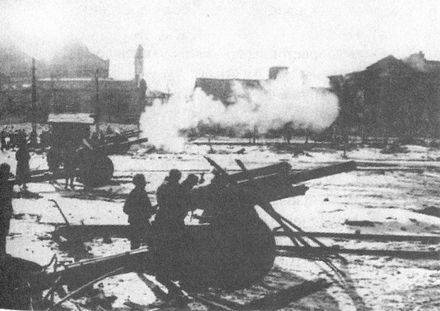
Soviet field artillery fires on Pest
By January 8, the Soviet troops separated only about 4 km from the Danube. The length of the Pest bridgehead from south to north has decreased to 15 km. The German-Hungarian command, realizing where things were going, that Malinovsky planned to divide and then destroy the northern and southern parts of the Pesht bridgehead, organized a series of desperate counterattacks. Hungarian troops, with the support of the shock groups of the Feldherrnhalle motorized division, stubbornly attacked and even managed to achieve local success, winning a number of positions. But it was a momentary success, soon the Soviet troops threw the enemy and continued to bite into his defense.
9 January 30-th Soviet Army Corps began a general assault on the station Rakoshrendze. From the beginning it was going hard. The German garrison, defending the station had a large number of machine guns, flamethrowers and was supported by tanks. But soon the station was taken. In order to avoid catastrophic fragmentation and subsequent encirclement, the German command ordered to withdraw a part of the troops to the north. The problem of ammunition further aggravated the position of the German-Hungarian troops. The air supply route to the troops was lost. High-speed boats began to be sent along the Danube, which mainly removed ammunition from the stranded barge.
11 January fights were already in the interior of the city. The Germans and Hungarians constantly counterattacked, but with heavy losses, continued to retreat, losing one position after another. In these battles, the Hungarians lost a significant part of the self-propelled guns. Soviet troops took Iozefstadtsky station. On January 12, the soldiers of the Feldherrnhalle division again moved to the north. The troops of the 13 Panzer Division counterattacked, but without much success. Parts of the 7 of the Romanian Army Corps took the building of cavalry barracks.
By January 13, the battle for Pest reached its climax. Endless attacks and counterattacks were accompanied by constant artillery and air strikes. Air raids almost paralyzed traffic on the Danube bridges. The bridges themselves were partially destroyed. Any transfer of reserves has become impossible. The soldiers of the Feldherrnhalle division were controlled, in fact, only by the 13 city district. The units of the Hungarian 10 Infantry Division were partially surrounded and attempted to reach their own. The broken units of the 10 Division left Pest and headed to Buda. Lieutenant-General Afonin, commander of the Soviet "Budapest Group", concentrated the blow on the 6 and 7 city districts.
January 14 fights continued with unrelenting heat. Soviet aviation dealt heavy blows at enemy positions. The 7 th Romanian corps moved more slowly than its neighbors, and when their flanks closed by 15 in January, the Romanians were in the rear. Therefore, by order of the front commander, the Romanian corps was withdrawn from the city. Two advancing Soviet corps stubbornly continued to break the enemy defenses.
On the eve of their entourage, the remnants of the German-Hungarian group left Rakos Street for the Big Ring during the night. German sappers blew up the bridge named after Miklos Horthy. At the Ring, German troops, with the support of the Hungarian assault guns, had difficulty restraining the advance of the Soviet troops. On January 16, under continuous air strikes, the Franz Joseph Bridge was destroyed. Separate enemy battle groups were surrounded. At night, the bridge was destroyed by Ferenc Jozef. According to German data, the bridge was destroyed by a direct hit of a projectile, the Hungarians believed that this was the work of a sabotage group.
In the evening of January 17, Budapest garrison commander Pfeffer-Wildenbruch received permission to evacuate Pest. At that time, only two bridges remained intact: a suspension bridge with chains and the Erzbety (Elizabeth) bridge. The retreat to the bridges across the Danube turned into a real doomsday. Under constant shelling, the Germans were somehow miraculously able to pull out almost all the remaining armored vehicles across the damaged bridges.
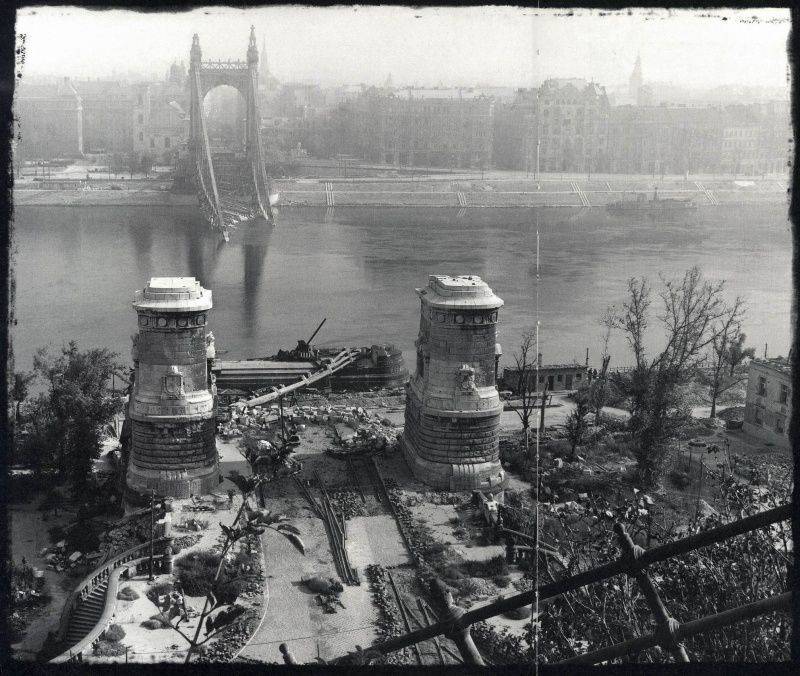
View of the Erzhebet bridge blown up by German troops in Budapest
By the morning of January 18, the Germans blew up the remaining crossings so that they would not get to the Soviet troops. At the same time the Hungarians were still on the bridges, and the evacuation of the Hungarian troops was not yet complete. It is worth saying that part of the Hungarian troops themselves sabotaged the evacuation. Hungarian soldiers were tired of the war, were angry at the will of the Germans and wanted to surrender. In the afternoon of January 18, the 18 Guards and the 30 Rifle Corps finally joined in the center of Pest, on the banks of the Danube. Part of the Hungarian troops was surrounded. Having taken part of the defense forces along the eastern bank of the Danube, two rifle corps engaged in the destruction of the surrounded enemy. During the day, organized resistance was broken.
After the destruction of the last bridges, the fighting in Pest continued for two more days. Soviet troops finished off the remnants of scattered surrounded enemy groups, disarmed and captured the remaining Hungarian units. In January alone 18 captured more than 18,5 thousand people, including 320 officers and 1 generals. After this, a long-awaited calm ensued in Pest.
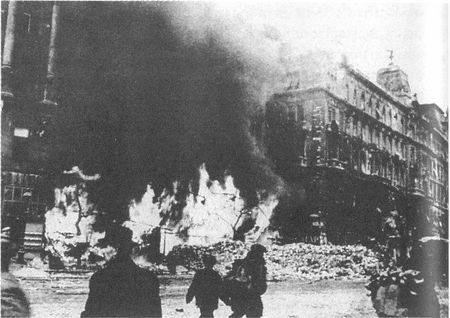
The Big Ring of Budapest is on fire. January 1945 of the year
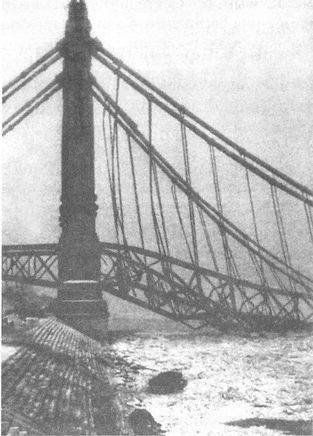
Collapsed Elizabethan bridge
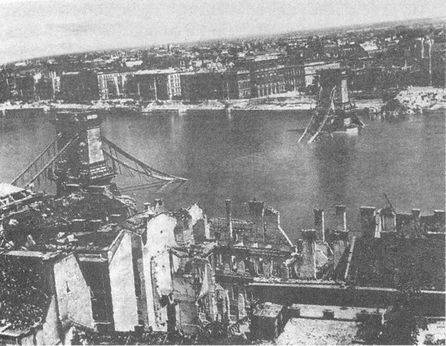
During the fighting in Budapest almost all the bridges across the Danube were destroyed
The beginning of the storming of Buda
By 24 December 1944 in Buda has developed a stable front line. It passed between Farkashreter cemetery and Olas Avenue. 25-26 December, the Soviet infantry gradually began to move forward. However, she was unable to make great progress, since the German command had formed sufficient forces to repel the first attacks. In addition, the troops of the 3 of the Ukrainian Front since the beginning of January of the 1945 waged heavy battles with the front to the west with the 4 SS Panzer Corps XNUMX rushing to the rescue of the Budapest group. Therefore, the attacks on the western part of the city were poorly organized and could not seriously shake the enemy defenses.
In the defense of Buda participated part of the 271-th People's Grenadier Division. The core of the defense of the western part of the Hungarian capital was originally the 8-I cavalry division of the SS "Florian Gayer", sent from Pest, it was transferred to the German shock battalion "Europe", the shock battalion "Bathy", several detachments made up of Hungarian gendarmes and other units .
The most active Soviet forces operated in the southern part of Buda, where they were able to quickly break from the suburbs to the city blocks. In the period from 25 to 28 December, the Albertfalva railway station, the Kelenfold station area, was seized. The Germans organized a counterattack to repel Kelenføy station. However, due to poor organization, the attack failed.
At the end of December - beginning of January, the stubborn battles followed the area of Varoshmayor, from which the nearest road to the Buda Castle ran. However, the loss of Buda automatically meant the collapse of the entire defense of Budapest, since without the western parts of the city the Germans would have no chance of unblocking the Hungarian capital. Therefore, the German command has done everything to strengthen the defense in the area of Varoshmayora. Enhanced battalion "Bath" took immediately three lines of defense. They consisted of various obstacles, trenches, machine-gun nests, mortar positions. Almost all the buildings in Varoshmayor were mined in order to destroy the Soviet troops, who would be hiding in the houses from enemy fire. In a number of buildings there were special units with armed panchershrek - hand-held anti-tank grenade launchers. To enhance the anti-tank defense, the battalion was given anti-aircraft and anti-tank guns. In order to ensure uninterrupted communication, the cables were specially stretched through the city sewer system.
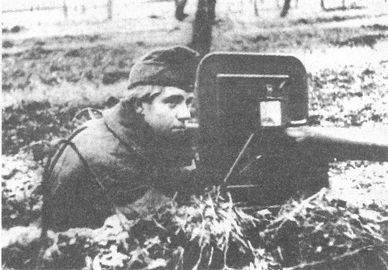
Hungarian soldier with a panzershrek type grenade launcher
December 31 Soviet units were able to storm the embankment in Ladmani. However, in the evening the Budapest battalion beat off the embankment, although it suffered huge losses. The German-Hungarian command had to transfer additional troops here. Later, soldiers from the Feldherrnhalle motorized division were transferred here. On this front, the situation remained stable until January 10, 1945. Although the assault groups formed from the best fighters of the 83 Brigade of the Marine Corps, more than once stormed the dam. Only January 11 took the dam.
Heavy fighting went on Eagle's Hill and Pink Hill. Only 3 January, the northernmost object in Buda, Mount Matthias, changed hands seven times. The defense on this site was held by the Berend battle group, which was entrenched in the building of the monastery of Notre-Dame de Zion. The fighting group was reinforced by detachments of the Hungarian gendarmerie. To the south and west of the mountain located barracks them. Karoya-Kiraya and Farkashreter cemetery, which were defended by the SS 8 Cavalry Division. Here, the defense kept the German and Hungarian anti-aircraft gunners. In addition, the defending troops supported the Hungarian assault guns.
The loss of Eagle Mountain meant that Soviet artillery would be able to freely fire on not only the airfield in Vermozo (Bloody Meadow), but also the Buda castle. Spotters would be able to coordinate the fire throughout the western part of the Hungarian capital. Therefore, the German-Hungarian troops stood to death. In the following days, fierce fighting continued. The situation was aggravated by the fact that Tolbukhin was forced to send significant forces to repel the German counter attack aimed at liberating the Budapest group. Breakthrough of the outer ring of the environment would mean a strong change in the strategic situation.
12 January Soviet troops were able to break through the enemy defenses and occupy the top of the mountain. However, the next day the enemy repulsed a strategic position. Only 15 January, Soviet troops were able to throw the enemy away from Eagle Mountains. January 16 German-Hungarian troops counterattacked, trying to repel the mountain. However, the massive Soviet artillery fire suppressed the attack.
Subsequently, heavy fighting went on in the area of the Farkashreter cemetery. Hungarian troops could not stand the onslaught of our troops. Therefore, the German command 20 January SS troops moved here. 25 January during a fierce battle, the SS were able to recapture a number of positions previously lost by the Hungarians. German-Hungarian troops used gravestones as defenses, and also created barricades between tombstones. As a result, this site was turned into a kind of "citadel".
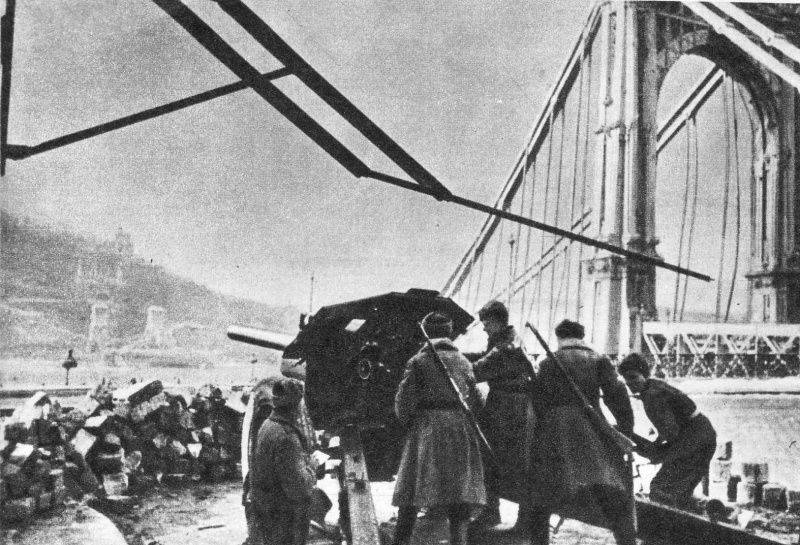
Calculation of the Soviet 122-mm howitzer M-30 in the battle for Budapest. On the right, the Erzhebet bridge blown up by German troops can be seen connecting Buda and Pest.
The inability to concentrate all efforts on the assault of Buda, the difficult conditions of the offensive in conditions of dense urban development, where the enemy had a lot of opportunities to create defense units, the fierce resistance of the German-Hungarian troops who were waiting for outside help and desperately fighting off, a significant amount of heavy weapons, all this dragged out siege of the western part of Budapest. In addition, the line of battles was confusing and Soviet artillery could not concentrate the fire on wide areas, so as not to hit their troops. And the narrow streets of the old city did not allow the use of tanks. As a result, Soviet troops moved very slowly throughout January, about a hundred meters a day.
German-Hungarian troops could not create a solid line of defense because of the narrow streets of the city and used the tactics of the chessboard. The Germans and the Hungarians defended separate, key areas, created strong points on the most important objects and large houses. In some areas, such defense was rather deep. Between these separate points of defense ("cells") there were no other lines of defense. They were covered with patrols, guard posts, and, if necessary, additional forces were sent to dangerous areas. In the depth of the defense, mobile reserves were located, which could at any time advance into a dangerous direction or launch a counterattack.
The advantage of the Budapest garrison was an excellent knowledge of the terrain and communications, including the underground. Quite often, Soviet troops attacked an enemy soldier who appeared from nowhere, although the area was already “cleansed”. Knowledge of communications, including underground, allowed the Germans and Hungarians to quickly transfer additional forces, to organize unexpected attacks.
It is worth noting that the tangled territory of a huge city, the battles among the masses of the civilian population, in every way contributed to the use of partisan tactics. As a result, both combatants sent each other in the rear reconnaissance and sabotage groups, who wore civilian clothes. On the front line, there were quite a few Hungarian soldiers on our side who had surrendered or weapons in the hands went over to the Red Army. Of these, the Buda civilian volunteer regiment was formed, which consisted of more than two thousand soldiers. Therefore, problems with the language of the Soviet saboteurs was not.
Due to the attempts of the German troops to unblock the Budapest garrison from the outside and the regrouping of the Soviet troops, the activity of the Soviet offensive in many sectors dropped significantly. Since January 3 and almost two weeks, there has been a relative lull in most of the combat sites. And even where there were active battles, there were many hours of respite.
17-19 On January, Soviet troops launched several attacks on the territories lying to the west of Eagle Mountain and from the Farkashreter cemetery. However, these attacks were repelled. At the same time, the troops evacuated from Pest somewhat stabilized the front, reinforcing the German-Hungarian defenses.
On January 18, the leadership of the operation to destroy the enemy group in Buda was entrusted to the 2-th Ukrainian Front. Therefore, the 75 th Guards Rifle Corps, 37 th Guards Rifle Corps and 83 brigade of marines besieged this part of the city were transferred from the 3-th Ukrainian Front to the 2-th Ukrainian Front. They were subordinated to the Budapest group of troops of Afonin. However, Afonin did not have to command Buda’s assault. On January 21, his car was shot at from an enemy plane at night and the general was seriously wounded. The commander of the 53 Army, Lieutenant General Ivan Managarov was appointed the new commander of the Budapest group of troops.
Simultaneously, the movement of troops in the opposite direction. So the stormed Pest 30 th infantry corps was transferred from the submission of Malinovsky to the submission of Tolbukhin. As a result, I would now be stormed by parts of the 75, 37 and 18 of the Guards Rifle Corps. They were reinforced by three artillery divisions, a mortar regiment, a guards mortar regiment, two assault engineering and sapper brigades, and two tank companies.
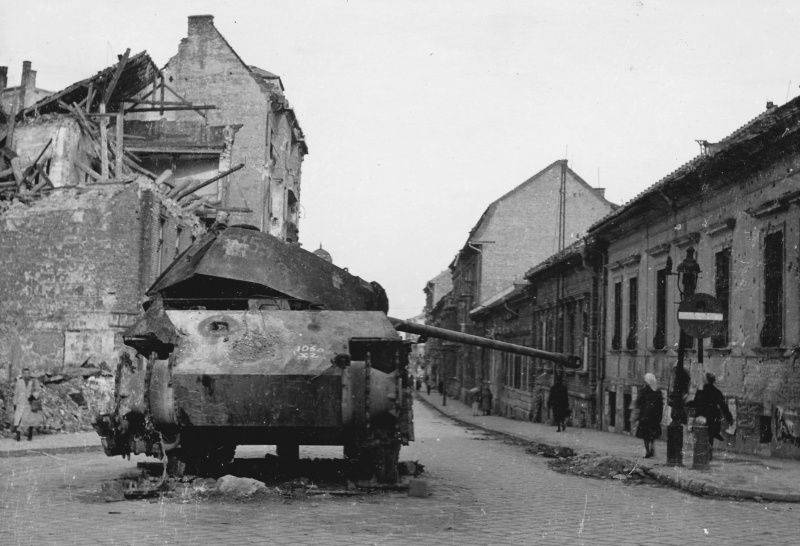
Downed and burned-out German tank "Panther" in one of the streets of Budapest
To be continued ...
Information